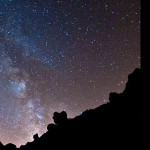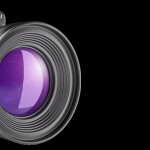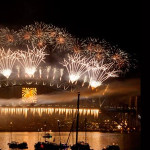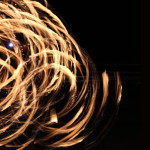Whether it is Christmas, New Years Eve, Independence day, the Olympic Games Opening/Closing ceremonies, Guy Fawkes night – or just about any major event, Fireworks displays often form the centerpiece of many public celebrations.
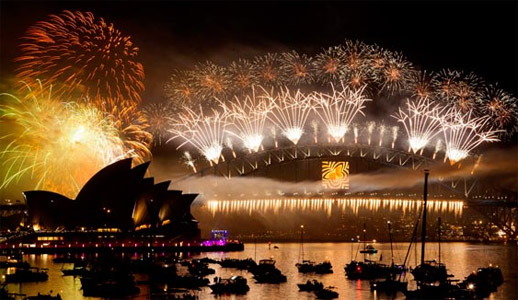 I’m sure you’ve admired spectacular photographs of fireworks, and wondered how the photographer does it. You may also have been a bit daunted by the prospect of photographing fireworks yourself – but there is no need – with a few simple techniques, you too should be able to take awesome firework photographs.
I’m sure you’ve admired spectacular photographs of fireworks, and wondered how the photographer does it. You may also have been a bit daunted by the prospect of photographing fireworks yourself – but there is no need – with a few simple techniques, you too should be able to take awesome firework photographs.
This post provides a quick and easy reference guide to taking photos of fireworks. It covers the basics of firework photography – allowing you to “give it a go” yourself and experiment to see which effects work best for you.
If you’re tired of your own festive pictures coming out grainy, blurry, underexposed, overexposed, or just plain dull and boring then this guide to firework photography should help
Camera Settings
It is easy to get overwhelmed with the many setting options available… But our suggestion is to keep it simple. We’ve outlined below suggested basic settings (although we do suggest you experiment with them for different effects)
Camera Mode
If your camera has one, definitely go with Manual mode – this gives you the greatest control and will allow you to take many shots that are just not possible in Auto modes.
ISO
You want the highest quality image possible so use the lowest possible ISO – we suggest an ISO of 100
Aperture
The light that the fireworks emit is quite bright, so apertures in the mid to small range tend to work well, we suggest an aperture setting between f/8 to f/16.
Shutter Speed
For fireworks photos, this is the most important camera setting you’ll need to worry about. What makes fireworks interesting is how their motion across the night sky illuminates a path and creates beautiful streaks and patterns. Your eye sees it, but with a fast shutter speed, your camera doesn’t.
So to give your camera a chance to record those streaks and patterns, you need to make sure your shutter is open long enough to get them in.
We suggest a shutter speed of a 3 to 6 seconds – which should be enough to capture a short burst, without overwhelming the photo with too may bursts (and probably overexposing the shot)
Focus
You will usually be shooting fireworks from quite some distance, it will also be dark, and your camera will probably have problems with auto focus, so select Manual focus, and set the focus to infinity.
Flash
Turn off the flash. The fireworks are bright enough, and your flash wouldn’t effectively reach them, but may overexpose elements in the foreground.
Choosing a Location
The spot you choose to take photos from is critical. Here are some things you should take into consideration.
- Try to work out where the fireworks will be bursting and get a spot with an unobstructed view of that area. You probably want to see fireworks in front of you, not above you.
- If the fireworks are popular (and most will be), you’ll need to show up early to get a good spot. Ideally scout out the location beforehand (one night before the event is ideal) and have an idea of some preferred spots (you may not be able to get the “perfect” one you want)
- Also try to determine the wind direction and get upwind of the fireworks so that your shots aren’t obscured by smoke blowing toward you.
- Find a spot where you can avoid getting a lot of extraneous ambient light in the picture, as this will cause an overexposure.
- When scouting out your location, choose some interesting features to serve as the background. This will make your photos more exciting for others to view.
- Watch out for trees and buildings which could block your view, and street lamps and other lighting which might make your exposures tricky.
- Try to find landmarks or other interesting things you can use to make your compositions more interesting.
- Try to find a unique vantage point: near a body of water that will reflect the fireworks, high up where the fireworks are at eye-level (on a rooftop, balcony, or bridge), etc. Get creative and go where other people aren’t.
Keep it Steady
Because you will be using timed exposures minimising camera movement is very important :
- Use a Tripod – make sure that you use a sturdy tripod. Also be mindful of others and try not to setup the tripod where it may obstruct (or can be bumped) buy others.
- Remote Shutter release – ideally use shutter release cable or remote shutter release in Bulb mode so you can determine exactly when and for how long the shutter is open – without actually touching the camera and potentially blurring the shot
- Image Stabilisation – Turn OFF (image stabilization) or VR (vibration reduction). This is designed to minimise camera shake when hand held, but when used on a tripod can actually cause instability.
Frame the Shot
You will probably need to “guess” where the action will be (and may need to move your tripod and reframe the shot partway through the fireworks display).
Frame carefully to exclude other light sources that might distract from the fireworks or cause your photos to be overexposed.
Don’t necessarily just point your camera at the sky, and consider using wider angles (rather than zooms) to capture other elements (e.g. trees, buildings, bridges, etc..)
You can often take more interesting fireworks photos by including buildings in the background or spectators in the foreground.
Technique
Frame the picture before shooting. Look through the viewfinder during the first few bursts and figure out where the action is. Point your camera at that spot and leave it there. You don’t want to be looking through the viewfinder while you’re trying to shoot, because you’ll likely shake the camera or your timing will be off.
Use the BULB (B) setting, which will keep the shutter open as long as the button is depressed. A rule of thumb is to open the shutter as soon as you hear or see the rocket shooting into the sky and to leave it open until the burst is dissipating. This will usually take several seconds.
Don’t keep your shutter open too long. The temptation is to think that because it’s dark that you can leave it open as long as you like. The problem with this is that fireworks are bright and it doesn’t take too much to over expose them, especially if your shutter is open for multiple bursts in the one area of the sky. By all means experiment with multiple burst shots – but most people end up finding that the simpler one burst shots can be best.
Make sure that you periodically check your results. Take a few shots at the start and do a quick check to see that they are OK before shooting any more. It is not necessary to check after every shot once you’ve got things set up OK (or you’ll miss the action) but do monitor yours shots occasionally to ensure you’re not taking a completely bad batch.
Experiment
A fireworks show usually involves many, many different types fireworks, with different effects, colours and styles, so be ready to experiment,
Different aperture and ISO settings will affect the brightness of the surroundings – bright surroundings are distracting, but subdued rather than completely black surroundings are much more interesting.
Also experiment with taking shots that include a wider perspective, silhouettes and people around you watching the display. Having your camera pointed at the sky can get you some wonderful shots but sometimes if you look for different perspectives you can get a few shots that are a little less cliche and just as spectacular.
Post Production
Many of the “most spectacular” firework photographs are actually made up of a combination of a number of different photos. It is quite common for example to combine several “bursts” to form a single “multi burst” photograph. You may also like to superimpose firework bursts onto an existing scene (e.g. a shot taken before the fireworks started). The technique for doing this is beyond the scope of this post, but we plan provide some How To Photo Editing Guides on this type of thing in the future.
